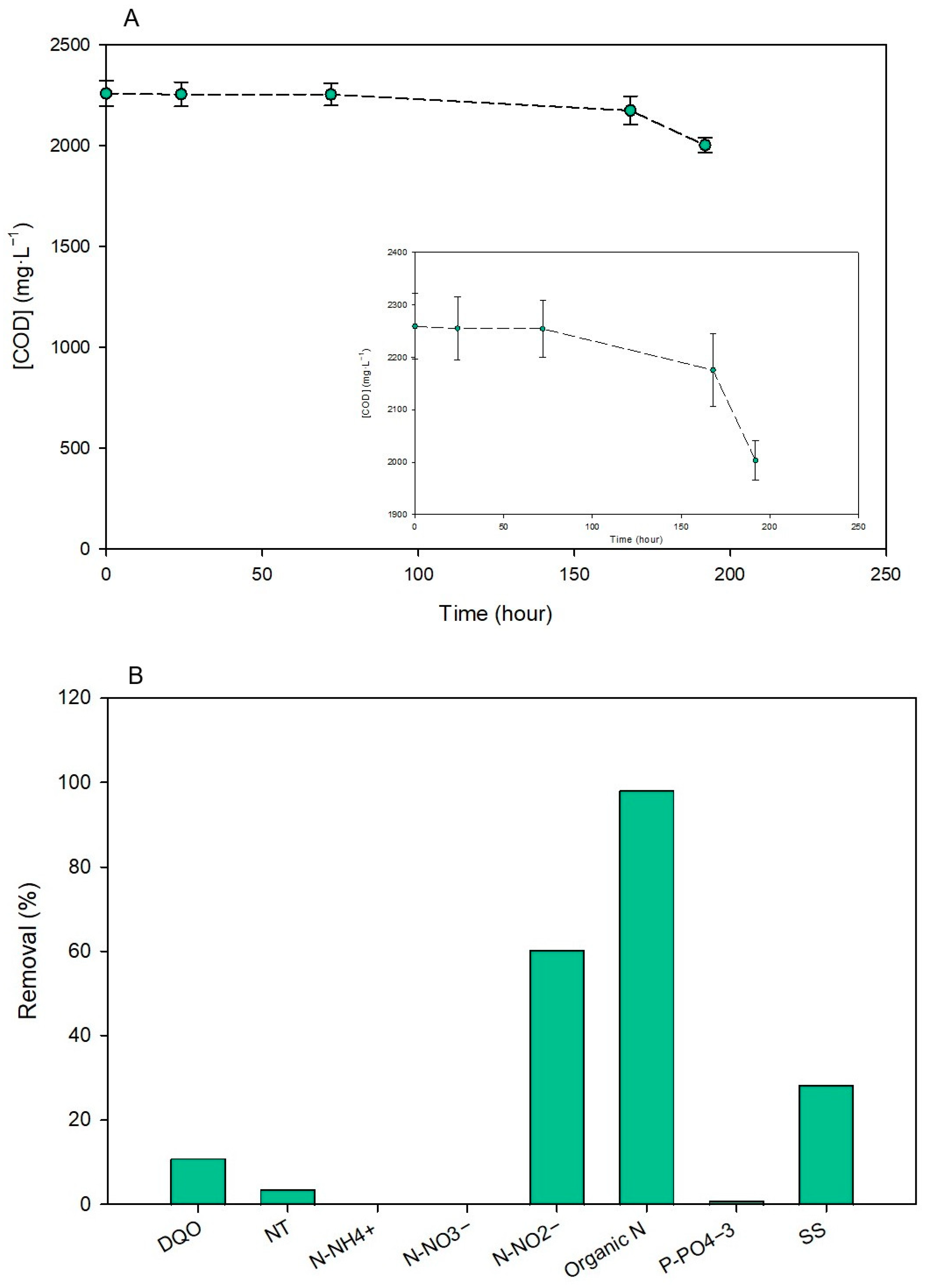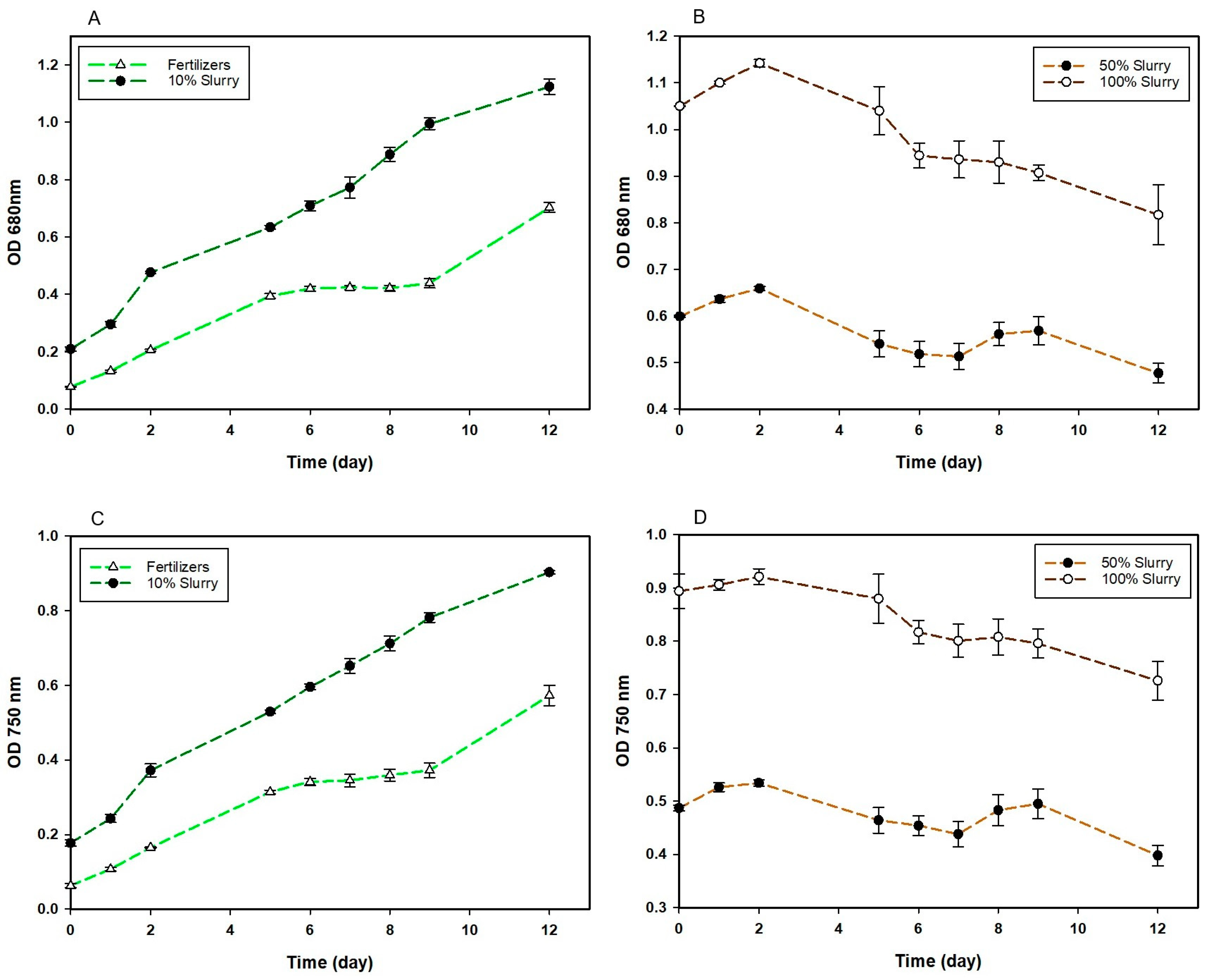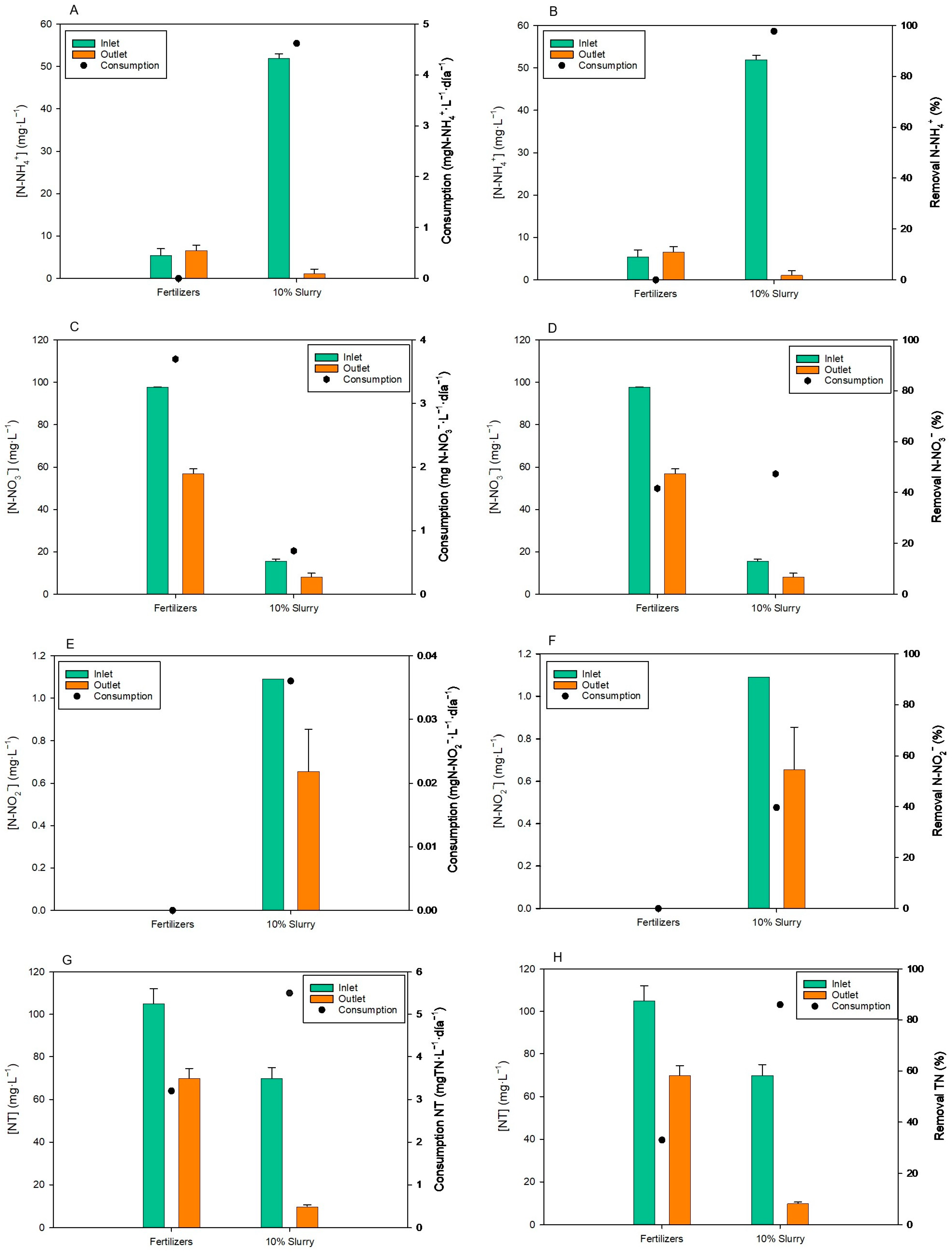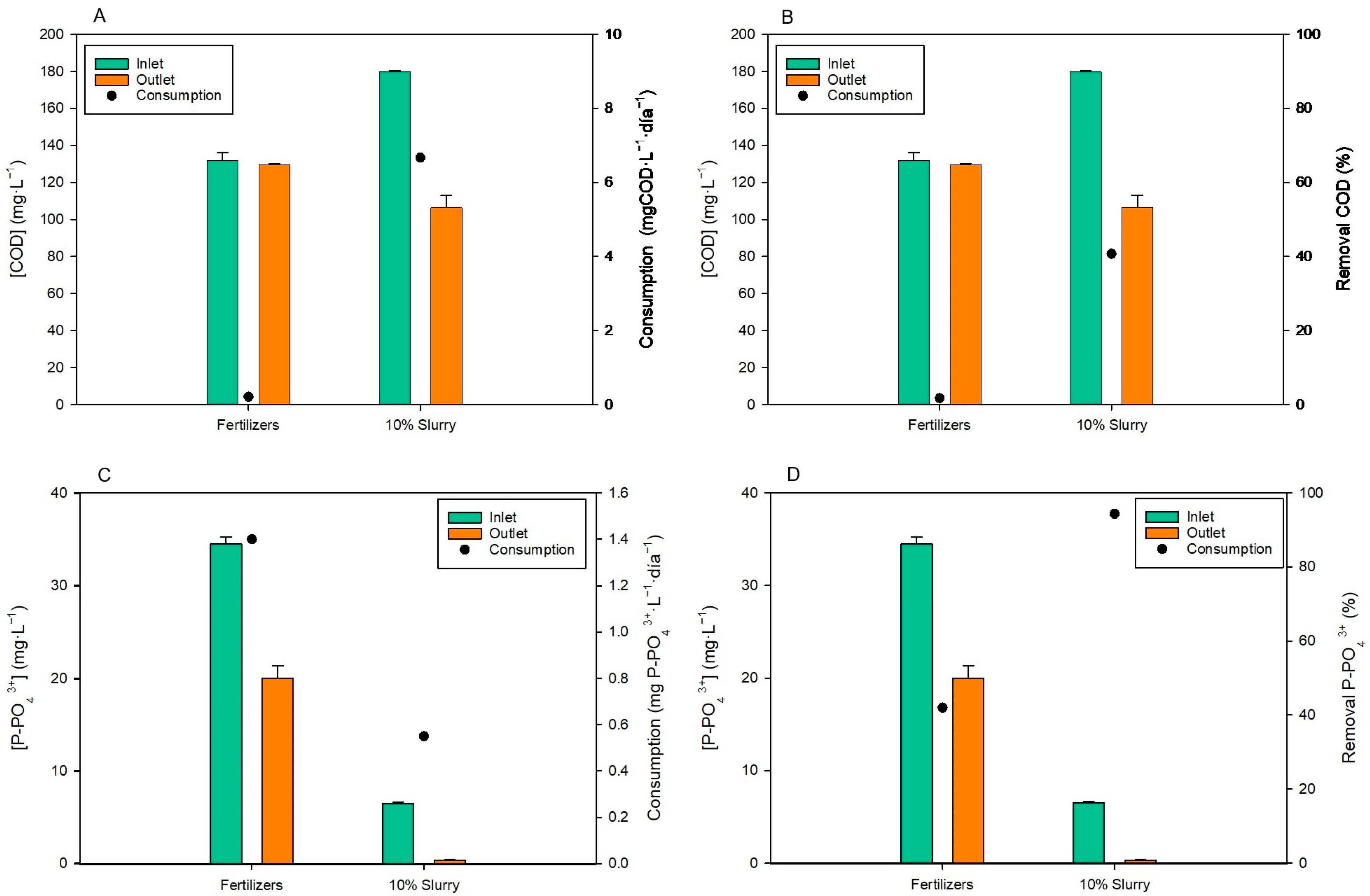Optimization of Recovery of Nutrients from Pig Manure Slurry through Combined Microbial Fuel Cell and Microalgae Treatment
Abstract
:1. Introduction
2. Materials and Methods
2.1. Micro-Organisms and Culture Media
2.2. Preparation of Proton Exchange Membranes with Catalytic Activity Based on Ionic Liquids
2.3. MFCs Test
2.4. Electrochemical Analysis
2.5. Lab-Scale Photobioreactors
2.6. Growth Monitoring
2.7. Chemical Analysis and Biomass Production
2.8. Statistical Analysis
3. Results
3.1. Slurry Pre-Treatment Using MFCs
3.1.1. Nutrient Removal
3.1.2. Electricity Generation
3.2. Slurry Treatment Using Microalgae–Bacteria Consortia
3.2.1. Culture Monitoring, Cell Growth and Biomass Productivity
3.2.2. Nutrient Recovery
4. Discussion
5. Conclusions
Author Contributions
Funding
Data Availability Statement
Acknowledgments
Conflicts of Interest
References
- Zandalinas, S.I.; Fritschi, F.B.; Mittler, R. Global Warming, Climate Change, and Environmental Pollution: Recipe for a Multifactorial Stress Combination Disaster. Trends Plant Sci. 2021, 26, 588–599. [Google Scholar] [CrossRef] [PubMed]
- Baicha, Z.; Salar-García, M.J.; Ortiz-Martínez, V.M.; Hernández-Fernández, F.J.; de los Ríos, A.P.; Labjar, N.; Lotfi, E.; Elmahi, M. A Critical Review on Microalgae as an Alternative Source for Bioenergy Production: A Promising Low Cost Substrate for Microbial Fuel Cells. Fuel Process. Technol. 2016, 154, 104–116. [Google Scholar] [CrossRef]
- Guo, Y.; Wang, J.; Shinde, S.; Wang, X.; Li, Y.; Dai, Y.; Ren, J.; Zhang, P.; Liu, X. Simultaneous Wastewater Treatment and Energy Harvesting in Microbial Fuel Cells: An Update on the Biocatalysts. RSC Adv. 2020, 10, 25874–25887. [Google Scholar] [CrossRef] [PubMed]
- Fangueiro, D.; Hjorth, M.; Gioelli, F. Acidification of Animal Slurry—A Review. J. Environ. Manag. 2015, 149, 46–56. [Google Scholar] [CrossRef]
- THE 17 GOALS | Sustainable Development. Available online: https://sdgs.un.org/es/goals (accessed on 13 June 2024).
- Ferreira, V.; Pié, L.; Mainar-Causapé, A.; Terceño, A. The Bioeconomy in Spain as a New Economic Paradigm: The Role of Key Sectors with Different Approaches. Environ. Dev. Sustain. 2024, 26, 3369–3393. [Google Scholar] [CrossRef]
- Kuchangi, S.N.; Mruthunjayappa, M.H.; Sanna Kotrappanavar, N. An Overview of Water Pollutants in Present Scenario. 3D Print. Technol. Water Treat. Appl. 2023, 83–105. [Google Scholar] [CrossRef]
- Logan, B.E.; Hamelers, B.; Rozendal, R.; Schröder, U.; Keller, J.; Freguia, S.; Aelterman, P.; Verstraete, W.; Rabaey, K. Microbial Fuel Cells: Methodology and Technology†. Environ. Sci. Technol. 2006, 40, 5181–5192. [Google Scholar] [CrossRef]
- Flimban, S.G.A.; Ismail, I.M.I.; Kim, T.; Oh, S.E. Overview of Recent Advancements in the Microbial Fuel Cell from Fundamentals to Applications: Design, Major Elements, and Scalability. Energies 2019, 12, 3390. [Google Scholar] [CrossRef]
- Du, Z.; Li, H.; Gu, T. A State of the Art Review on Microbial Fuel Cells: A Promising Technology for Wastewater Treatment and Bioenergy. Biotechnol. Adv. 2007, 25, 464–482. [Google Scholar] [CrossRef]
- Hernández-Fernández, F.J.; Pérez De Los Ríos, A.; Salar-García, M.J.; Ortiz-Martínez, V.M.; Lozano-Blanco, L.J.; Godínez, C.; Tomás-Alonso, F.; Quesada-Medina, J. Recent Progress and Perspectives in Microbial Fuel Cells for Bioenergy Generation and Wastewater Treatment. Fuel Process. Technol. 2015, 138, 284–297. [Google Scholar] [CrossRef]
- Aghababaie, M.; Farhadian, M.; Jeihanipour, A.; Biria, D. Effective Factors on the Performance of Microbial Fuel Cells in Wastewater Treatment—A Review. Environ. Technol. Rev. 2015, 4, 71–89. [Google Scholar] [CrossRef]
- Cai, T.; Park, S.Y.; Li, Y. Nutrient Recovery from Wastewater Streams by Microalgae: Status and Prospects. Renew. Sustain. Energy Rev. 2013, 19, 360–369. [Google Scholar] [CrossRef]
- Oswald, W.J.; Gotaas, H.B.; Ludwig, H.F.; Lynch, V. Algae Symbiosis in Oxidation Ponds. III. Photosynthetic Oxygenation. Sew. Ind. Wastes 1953, 25, 692–705. [Google Scholar]
- Fallahi, A.; Rezvani, F.; Asgharnejad, H.; Khorshidi, E.; Hajinajaf, N.; Higgins, B. Interactions of Microalgae-Bacteria Consortia for Nutrient Removal from Wastewater: A Review. Chemosphere 2021, 272, 129878. [Google Scholar] [CrossRef] [PubMed]
- Srimongkol, P.; Sangtanoo, P.; Songserm, P.; Watsuntorn, W.; Karnchanatat, A. Microalgae-Based Wastewater Treatment for Developing Economic and Environmental Sustainability: Current Status and Future Prospects. Front. Bioeng. Biotechnol. 2022, 10, 904046. [Google Scholar] [CrossRef]
- Morales-Amaral, M.d.M.; Gómez-Serrano, C.; Acién, F.G.; Fernández-Sevilla, J.M.; Molina-Grima, E. Outdoor Production of Scenedesmus Sp. in Thin-Layer and Raceway Reactors Using Centrate from Anaerobic Digestion as the Sole Nutrient Source. Algal Res. 2015, 12, 99–108. [Google Scholar] [CrossRef]
- Hernández-Fernández, F.J.; De Los Ríos, A.P.; Mateo-Ramírez, F.; Juarez, M.D.; Lozano-Blanco, L.J.; Godínez, C. New Application of Polymer Inclusion Membrane Based on Ionic Liquids as Proton Exchange Membrane in Microbial Fuel Cell. Sep. Purif. Technol. 2016, 160, 51–58. [Google Scholar] [CrossRef]
- ISO 23695:2023; Water Quality—Determination of Ammonium Nitrogen in Water—Small-Scale Sealed Tube Method. International Organization for Standardization: Geneva, Switzerland, 2023.
- Article, R.; De Brito Andrade, L.; Martín-Gómez, C.; Zuazua-Ros, A.; Ariño, A.H. Livestock Buildings: Influence of Indoor Environment, Rearing Systems, And Manure Management. J. Vet. Health Sci. 2022, 3, 223–249. [Google Scholar]
- Szogi, A.A.; Vanotti, M.B.; Ro, K.S. Methods for Treatment of Animal Manures to Reduce Nutrient Pollution Prior to Soil Application. Curr. Pollut. Rep. 2015, 1, 47–56. [Google Scholar] [CrossRef]
- Hasan, M.R.; Anzar, N.; Sharma, P.; Malode, S.J.; Shetti, N.P.; Narang, J.; Kakarla, R.R. Converting Biowaste into Sustainable Bioenergy through Various Processes. Bioresour. Technol. Rep. 2023, 23, 101542. [Google Scholar] [CrossRef]
- Sajjad, M.; Huang, Q.; Khan, S.; Nawab, J.; Khan, M.A.; Ali, A.; Ullah, R.; Kubar, A.A.; Guo, G.; Yaseen, M.; et al. Methods for the Removal and Recovery of Nitrogen and Phosphorus Nutrients from Animal Waste: A Critical Review. Ecol. Front. 2024, 44, 2–14. [Google Scholar] [CrossRef]
- Ferreira, A.; Figueiredo, D.; Ferreira, F.; Marujo, A.; Bastos, C.R.V.; Martin-Atanes, G.; Ribeiro, B.; Štěrbová, K.; Marques-dos-Santos, C.; Acién, F.G.; et al. From Piggery Wastewater to Wheat Using Microalgae towards Zero Waste. Algal Res. 2023, 72, 103153. [Google Scholar] [CrossRef]
- López-Serna, R.; Franco, B.; Bolado, S.; Jiménez, J.J. Removal of Contaminants of Emerging Concern from Pig Manure in Different Operation Stages of a Thin-Layer Cascade Photobioreactor. Relationship with Concentrations in Microalgae and Manure. J. Environ. Manag. 2024, 354, 120340. [Google Scholar] [CrossRef] [PubMed]
- Zambrano, J.; García-Encina, P.A.; Jiménez, J.J.; Ciardi, M.; Bolado-Rodríguez, S.; Irusta-Mata, R. Removal of Veterinary Antibiotics in Swine Manure Wastewater Using Microalgae–Bacteria Consortia in a Pilot Scale Photobioreactor. Environ. Technol. Innov. 2023, 31, 103190. [Google Scholar] [CrossRef]
- Ciardi, M.; Gómez-Serrano, C.; Morales-Amaral, M.d.M.; Acién, G.; Lafarga, T.; Fernandez-Sevilla, J.M. Optimisation of Scenedesmus Almeriensis Production Using Pig Slurry as the Sole Nutrient Source. Algal Res. 2022, 61, 102580. [Google Scholar] [CrossRef]
- Xie, B.; Gong, W.; Ding, A.; Yu, H.; Qu, F.; Tang, X.; Yan, Z.; Li, G.; Liang, H. Microbial Community Composition and Electricity Generation in Cattle Manure Slurry Treatment Using Microbial Fuel Cells: Effects of Inoculum Addition. Environ. Sci. Pollut. Res. Int. 2017, 24, 23226–23235. [Google Scholar] [CrossRef]
- Min, B.; Kim, J.R.; Oh, S.E.; Regan, J.M.; Logan, B.E. Electricity Generation from Swine Wastewater Using Microbial Fuel Cells. Water Res. 2005, 39, 4961–4968. [Google Scholar] [CrossRef]
- Sánchez-Zurano, A.; Ciardi, M.; Lafarga, T.; Fernández-Sevilla, J.M.; Bermejo, R.; Molina-Grima, E. Role of Microalgae in the Recovery of Nutrients from Pig Manure. Processes 2021, 9, 203. [Google Scholar] [CrossRef]
- Nam, J.Y.; Kim, H.W.; Shin, H.S. Ammonia Inhibition of Electricity Generation in Single-Chambered Microbial Fuel Cells. J. Power Sources 2010, 195, 6428–6433. [Google Scholar] [CrossRef]
- Hopkinson, C.S.; Giblin, A.E. Nitrogen Dynamics of Coastal Salt Marshes. In Nitrogen in the Marine Environment; Academic Press: Cambridge, MA, USA, 2008; pp. 991–1036. [Google Scholar] [CrossRef]
- Hernández-Fernández, A.; Iniesta-López, E.; Garrido, Y.; Ieropoulos, I.A.; Hernández-Fernández, F.J. Microbial Fuel Cell Using a Novel Ionic-Liquid-Type Membrane-Cathode Assembly with Heterotrophic Anodic Denitrification for Slurry Treatment. Sustainability 2023, 15, 14817. [Google Scholar] [CrossRef]
- Ni, S.Q.; Zhang, J. Anaerobic Ammonium Oxidation: From Laboratory to Full-Scale Application. BioMed Res. Int. 2013, 2013, 469360. [Google Scholar] [CrossRef] [PubMed]
- Haque, S.E.; Chowdhury, B.; Sujauddin, M.; An, C. How Effective Are Existing Phosphorus Management Strategies in Mitigating Surface Water Quality Problems in the U.S.? Sustainability 2021, 13, 6565. [Google Scholar] [CrossRef]
- Hirooka, K.; Ichihashi, O. Phosphorus Recovery from Artificial Wastewater by Microbial Fuel Cell and Its Effect on Power Generation. Bioresour. Technol. 2013, 137, 368–375. [Google Scholar] [CrossRef] [PubMed]
- Venkata Mohan, S.; Velvizhi, G.; Annie Modestra, J.; Srikanth, S. Microbial Fuel Cell: Critical Factors Regulating Bio-Catalyzed Electrochemical Process and Recent Advancements. Renew. Sustain. Energy Rev. 2014, 40, 779–797. [Google Scholar] [CrossRef]
- Gunaseelan, K.; Gajalakshmi, S.; Kamaraj, S.K.; Solomon, J.; Jadhav, D.A. Electrochemical Losses and Its Role in Power Generation of Microbial Fuel Cells. In Bioelectrochemical Systems Vol. 1 Principles and Processes; Springer: Berlin/Heidelberg, Germany, 2021; pp. 81–118. [Google Scholar] [CrossRef]
- Andrade, P.; Laadjal, K.; Alcaso, A.N.; Cardoso, A.J.M. A Comprehensive Review on Condition Monitoring and Fault Diagnosis in Fuel Cell Systems: Challenges and Issues. Energies 2024, 17, 657. [Google Scholar] [CrossRef]
- Wang, M.; Yang, Y.; Chen, Z.; Chen, Y.; Wen, Y.; Chen, B. Removal of Nutrients from Undiluted Anaerobically Treated Piggery Wastewater by Improved Microalgae. Bioresour. Technol. 2016, 222, 130–138. [Google Scholar] [CrossRef]
- Geider, R.J.; La Roche, J. Redfield Revisited: Variability of C:N:P in Marine Microalgae and Its Biochemical Basis. Eur. J. Phycol. 2002, 37, 1–17. [Google Scholar] [CrossRef]
- Villaró, S.; Sánchez-Zurano, A.; Ciardi, M.; Alarcón, F.J.; Clagnan, E.; Adani, F.; Morillas-España, A.; Álvarez, C.; Lafarga, T. Production of Microalgae Using Pilot-Scale Thin-Layer Cascade Photobioreactors: Effect of Water Type on Biomass Composition. Biomass Bioenergy 2022, 163, 106534. [Google Scholar] [CrossRef]
- Fuentes, J.L.; Garbayo, I.; Cuaresma, M.; Montero, Z.; González-Del-Valle, M.; Vílchez, C. Impact of Microalgae-Bacteria Interactions on the Production of Algal Biomass and Associated Compounds. Mar. Drugs 2016, 14, 100. [Google Scholar] [CrossRef]
- Bunce, J.T.; Ndam, E.; Ofiteru, I.D.; Moore, A.; Graham, D.W. A Review of Phosphorus Removal Technologies and Their Applicability to Small-Scale Domestic Wastewater Treatment Systems. Front. Environ. Sci. 2018, 6, 290291. [Google Scholar] [CrossRef]
- Rezvani, F.; Sarrafzadeh, M.H.; Oh, H.M. Hydrogen Producer Microalgae in Interaction with Hydrogen Consumer Denitrifiers as a Novel Strategy for Nitrate Removal from Groundwater and Biomass Production. Algal Res. 2020, 45, 101747. [Google Scholar] [CrossRef]
- Powell, N.; Shilton, A.; Chisti, Y.; Pratt, S. Towards a Luxury Uptake Process via Microalgae—Defining the Polyphosphate Dynamics. Water Res. 2009, 43, 4207–4213. [Google Scholar] [CrossRef] [PubMed]
- Solovchenko, A.E.; Ismagulova, T.T.; Lukyanov, A.A.; Vasilieva, S.G.; Konyukhov, I.V.; Pogosyan, S.I.; Lobakova, E.S.; Gorelova, O.A. Luxury Phosphorus Uptake in Microalgae. J. Appl. Phycol. 2019, 31, 2755–2770. [Google Scholar] [CrossRef]
- Sánchez-Zurano, A.; Gómez-Serrano, C.; Acién-Fernández, F.G.; Fernández-Sevilla, J.M.; Molina-Grima, E. A Novel Photo-Respirometry Method to Characterize Consortia in Microalgae-Related Wastewater Treatment Processes. Algal Res. 2020, 47, 101858. [Google Scholar] [CrossRef]







| Slurry | |
|---|---|
| COD (mg·L−1) | 2259.3 ± 73.1 |
| BOD5 (mg·L−1) | 888.6 ± 31.4 |
| TN (mg·L−1) | 603.3 ± 28.9 |
| N-NH4+ (mg·L−1) | 538 ± 36.6 |
| N-NO3− (mg·L−1) | 0.0 |
| N-NO2− (mg·L−1) | 0.04 ± 0.00 |
| N-organic (mg·L−1) | 65.3 ± 5.1 |
| P-PO4−3 (mg·L−1) | 14.1 ± 0.6 |
| SS (g·L−1) | 0.83 ± 0.0 |
Disclaimer/Publisher’s Note: The statements, opinions and data contained in all publications are solely those of the individual author(s) and contributor(s) and not of MDPI and/or the editor(s). MDPI and/or the editor(s) disclaim responsibility for any injury to people or property resulting from any ideas, methods, instructions or products referred to in the content. |
© 2024 by the authors. Licensee MDPI, Basel, Switzerland. This article is an open access article distributed under the terms and conditions of the Creative Commons Attribution (CC BY) license (https://creativecommons.org/licenses/by/4.0/).
Share and Cite
Hernández-Fernández, A.; Iniesta-López, E.; Hernández Baños, A.I.; Garrido, Y.; Sánchez Zurano, A.; Hernández-Fernández, F.J.; De los Ríos, A.P. Optimization of Recovery of Nutrients from Pig Manure Slurry through Combined Microbial Fuel Cell and Microalgae Treatment. Processes 2024, 12, 1989. https://doi.org/10.3390/pr12091989
Hernández-Fernández A, Iniesta-López E, Hernández Baños AI, Garrido Y, Sánchez Zurano A, Hernández-Fernández FJ, De los Ríos AP. Optimization of Recovery of Nutrients from Pig Manure Slurry through Combined Microbial Fuel Cell and Microalgae Treatment. Processes. 2024; 12(9):1989. https://doi.org/10.3390/pr12091989
Chicago/Turabian StyleHernández-Fernández, Adrián, Eduardo Iniesta-López, Ana Isabel Hernández Baños, Yolanda Garrido, Ana Sánchez Zurano, Francisco J. Hernández-Fernández, and Antonia Pérez De los Ríos. 2024. "Optimization of Recovery of Nutrients from Pig Manure Slurry through Combined Microbial Fuel Cell and Microalgae Treatment" Processes 12, no. 9: 1989. https://doi.org/10.3390/pr12091989









